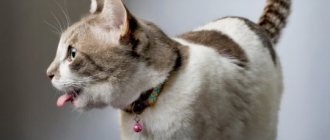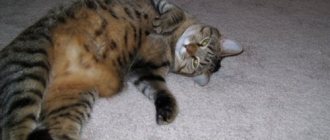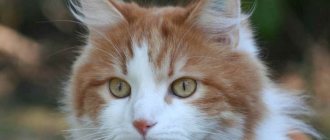If your pet has an incomprehensible cry, meowing or wheezing, you should contact your veterinarian. Sometimes a cat wheezes and sniffles when breathing due to the accumulation of fluid in the bronchi, but other factors can also influence the occurrence of an unpleasant symptom. With many deviations, owners observe that the pet is not only hoarse, but also salivates profusely, breathes poorly, the volume of fluid in the nose increases and behaves restlessly. It is difficult to treat the disorder on your own, and sometimes even dangerous for the health and life of your pet, so as soon as the cat’s voice has disappeared, you should immediately contact a veterinary clinic.
Varieties
If the owners find that the cat wheezes when he breathes, wheezing and other pathological noises are recorded, then it is worth taking the pet to the veterinarian. Such a violation is divided into several types, presented in the table:
| Type | Peculiarities |
| Fine bubbles | The pathological sound is a consequence of the collapse of small air balls that are formed during sputum |
| Such wheezing is heard when the pet is sleeping or awake, and is characteristic of bronchitis, pneumonia and pulmonary infarction. | |
| Medium bubble | Reminds me of the sound of air blown through a tube |
| Observed with inflammation of the bronchi, which is associated with abundant accumulation of mucus | |
| Large-vesicular | Can be listened to without special devices |
| The cat exhibits noisy breathing with severe wheezing, and the pet can often burp liquid accumulated in the lungs | |
| Caused by pulmonary edema |
Veterinarians note that the cat may experience wheezing, whistling, dry or wet. At the same time, different types of noise are associated with different reasons and require special treatment.
When to take your cat to the vet
If your cat sniffles frequently, or breathes with her mouth open, this should alert you and cause a visit to the veterinarian. Before you see a doctor, you need to observe the animal for a couple of days in order to correctly answer questions in the veterinary hospital to make the correct diagnosis. The veterinarian may be interested in the following information:
- how long ago did the snoring begin?
- are there any accompanying sounds along with wheezing during breathing;
- whether the pet was injured;
- whether the animal’s usual behavior has changed;
- was there a change in the color of the mucous membranes;
- other symptoms (vomiting, runny nose, cough).
Persistent breathing problems can cause more serious health problems.
By the nature of snoring and additional sounds, you can determine the source of the disease:
- wheezing, coughing and blue mucous membranes signal heart failure;
- wheezing and wheezing indicate the presence of urolithiasis;
- wet rales may indicate phlegm in the respiratory system;
- crackling indicates problems in the alveoli;
- dry wheezing indicates the presence of edema in the bronchi or larynx;
- sniffling plus whistling may indicate swelling in the airway area.
A correct diagnosis and timely initiation of treatment will ensure a speedy recovery for the cat. There is no need to rely on the advice of other cat owners or information on websites. Each case is individual, even if the symptoms are similar.
Why is there a problem?
Pulmonary causes and additional symptoms
Cough is one of the main symptoms of rhinotracheitis in an animal.
If the kitten does not meow and its respiratory rhythm has changed, then in most cases the problem is associated with pathologies of the respiratory system. Many pulmonary diseases are characterized by copious secretion of saliva and mucus, which the pet often swallows. If a cat is breathing heavily and wheezing constantly, then this indicates a number of pathologies presented in the table.
| Disease | Short description | Additional symptoms |
| Rhinotracheitis and calcivirosis | The mucous membranes of the respiratory tract and intestines become inflamed | Heat |
| Diarrhea | ||
| Cough and severe wheezing | ||
| Ulcers on the mucous membranes | ||
| Purulent and mucous discharge from the eyes and nose | ||
| Pneumonia | Inflammatory reaction in the lungs associated with viruses and bacteria | Barking type cough |
| Temperature increase | ||
| Deterioration of general condition | ||
| Bronchial asthma | Chronic inflammation of the airways with narrowing of the pulmonary lumen | Frequently pressing the cat to the floor |
| The animal is breathing hoarsely and coughing | ||
| In advanced cases, the pet suffocates | ||
| Helminthiasis | Associated with the entry of small parasites into the respiratory tract | Vomiting and nausea |
| Breathing with wheezing | ||
| Broken stool | ||
| The pet eats almost nothing | ||
| Cancerous tumors | Accompanied by the proliferation of malignant cells in the respiratory organs | The cat grunts and sniffles when it breathes |
| Changed voice, and sometimes meowing disappears completely | ||
| Shortness of breath and cough with bloody impurities | ||
| Laryngeal edema or laryngospasm | Occurs against the background of poisoning with household chemicals, an allergic or autoimmune reaction | Acute lack of oxygen |
| Restless state | ||
| The cat meows hoarsely and moans often |
Other reasons can also affect heavy breathing in a cat and severe wheezing:
The animal may experience difficulty breathing due to the triplication of the skull.
- foreign body entering the throat;
- brachycephalic syndrome;
- pulmonary edema;
- congenital anomalies;
- tracheal collapse.
Non-respiratory sources
When a cat has hoarse breathing accompanied by a loud sound, this does not always signal a pathology in the respiratory system. Often a cat grunts and breathes through his mouth due to the following disorders:
- Protrusion of the diaphragmatic hernia. The symptoms are reminiscent of bronchial asthma, with the pet constantly being in one position and breathing heavily.
- Heart diseases. In case of heart failure, the animal rarely develops a cough, and the cat often wheezes and breathes through his mouth. Arrhythmia, myocardosis and myocarditis can affect impaired breathing.
- Severe renal failure. The pathology often provokes pulmonary edema, as a result of which the pet refuses to eat, is constantly in a semi-sitting position and coughs.
Normal cat condition
If your feline pet sniffles, but does not express any pain, his behavior has not changed, he plays, eats well, you need to examine the animal:
- if the nasal mucosa is pink, then the body receives enough oxygen;
- there is no discharge from the nose, which means a cold is excluded;
- Light pressure over the entire back will help determine whether there are or are no areas of pain.
Breathing with wheezing may be caused by a deviated nasal septum or obesity, which is not life-threatening.
When your cat sniffles, she also scratches her nose with her paws and sneezes; perhaps she just has an allergy, which will disappear after the allergen is eliminated.
We invite you to familiarize yourself with the TOP 17 reasons why a cat constantly meows
Periodic snoring is normal for humans and animals.
Diagnostics
At the appointment, the doctor may examine the animal’s throat.
If your cat becomes hoarse, breathes with its tongue hanging out, and sneezes frequently, then you should immediately contact a veterinary clinic. Such symptoms indicate serious illnesses in the respiratory and other systems of the cat’s body. During diagnosis, a specialist uses special instruments to examine the animal’s throat to detect a foreign object, which most often leads to wheezing. The veterinarian asks the animal owner what other symptoms have been present and for how long. If the cat begins to breathe heavily in its stomach, wheeze and cough, then to make an accurate diagnosis and find out the cause of the problem, the following diagnostic procedures are performed:
- laboratory testing of blood and urine;
- analysis of feces for the presence of helminths;
- biopsy of damaged tissue;
- ultrasound diagnostics;
- radiography.
Treatment methods
There are situations when an animal suddenly stops breathing, the owner should know how to provide first aid. If breathing stops, an indirect cardiac massage must be started immediately. The cat should be placed on a flat surface in such a way that the line of the spine is straight.
Treatment is prescribed after the diagnosis has been clarified. If helminths are detected, anthelmintic drugs are given. Vitamin complexes are prescribed to maintain heart function. The cause of wheezing is determined by x-ray. Only proper treatment will quickly restore your cat's health.
Many cats, especially young ones, love to frolic and run around, and after that, tired, they lie lazily spread out and breathe frequently. However, what should you do if the cat is breathing heavily, but has not run before? This should alert every attentive owner.
What to do and how to treat?
If your cat wheezes, has stopped meowing, and other alarming symptoms are observed, then you should immediately seek veterinary help. If nothing is done for certain diseases of the respiratory system, the pathology rapidly progresses and can lead to severe shortness of breath, lack of oxygen and death of the pet. Therapeutic measures are selected individually for each pet, depending on what is causing the cat’s wheezing. If owners observe that the pet is constantly trying to clear its throat and wheezing, then there is a high probability of a respiratory disease. In this case, you must adhere to the following therapeutic actions:
If the animal refuses to drink, you need to use a syringe without a needle to inject water.
- Provide the cat with constant access to drinking water. If the animal refuses, then try to inject the liquid with a syringe.
- Constant air humidification and ventilation in the place where the sick pet lives.
- Taking medications that provide symptomatic treatment.
Veterinarians warn that if a cat has a hoarse voice due to respiratory failure or asthma, then forceful watering is strictly prohibited. In this case, excess fluid is removed from the lungs, and in severe cases, surgery is performed.
Medications should be given to a sick animal for wheezing only on the recommendation of a veterinarian, since many of them have contraindications and can cause complications. If wheezing is associated with diseases of an infectious nature, then therapy must be supplemented with antibiotics. If the symptoms are accompanied by foamy nasal discharge with bloody impurities, then emergency hospitalization of the animal is required, since the risk of death is high.
Diagnostic methods
To make a preliminary diagnosis and select diagnostic methods, the doctor resorts to the following methods:
- examination of the animal’s upper respiratory tract, mucous membranes, eyes;
- auscultation (listening) of the trachea, bronchi and lungs;
- analysis of data on the conditions of keeping and nutrition of a four-legged patient, information about previous diseases suffered by him, features of the onset of the present pathological process;
- comparison of the animal’s weight with the norm for a given breed and age.
After carrying out the initial diagnostic procedures, the veterinarian prescribes the following types of laboratory and instrumental studies to the four-legged patient:
- clinical, biochemical, virological and bacteriological blood analysis;
- stool examination;
- Ultrasound and electrocardiogram of the heart;
- rhinoscopy;
- bronchoscopy;
- X-ray of the chest organs.
You may also need to consult with specialists. If necessary, the animal is prescribed a dental, oncological and surgical examination. The listed diagnostic procedures are standard. Such procedures are prescribed depending on the clinical picture.
Prevention measures
To prevent your cat from wheezing, you need to regularly monitor his health and regularly visit the veterinarian. Timely deworming and vaccination help reduce the likelihood of difficulty breathing. In most cases, wheezing is recorded due to disorders of the respiratory tract. To prevent such diseases, you should not allow hypothermia and give your pet cold food and water. It is important to eliminate all possible allergens and monitor the animal so that it does not ingest any foreign objects. If you have difficulty breathing or other alarming symptoms, you should not self-medicate, but should immediately contact a veterinarian so that your pet does not die.
Why can a cat sniff and grunt when breathing?
Quite often, a cat's breathing is accompanied by wheezing. As a rule, physiological factors act as the causes of this phenomenon. Such snoring should not cause concern to the pet owner.
When an animal is breathing heavily, grunting, sniffling and whistling through its nose, you should immediately show it to a veterinarian. Ignoring these symptoms caused by pathological factors can lead to serious consequences, including the death of the cat.
We suggest you read: Is it possible to give lard to chickens?
The respiratory system of these animals is similar in structure to humans. They, just like people, can sigh, sniffle, grunt, and snore. In most cases, this occurs due to natural causes and should not be a cause for concern. Your pet's wheezing may appear against the background of:
- Excessive physical activity. In healthy individuals, the respiratory rate depends on the degree of load. A cat breathes most calmly during sleep.
- Nervous shock. Experiencing excitement, fear, rage and excitement, the cat begins to breathe noisily. Breathing may be accompanied by wheezing. This is a short-term condition. It goes away after the source of stress disappears.
- Bearing offspring, feeding young and sexual desire. In all these situations, the cat's breathing quickens.
- Overheating. An overheated pet inhales air not through its nose, but through its mouth. He does it hard, with a whistle. The cat instinctively tries to spread out his whole body on the floor in the coolest room, usually on the tiles in the bathroom.
Among the pathological reasons that a pet is breathing loudly are:
- Swelling of the larynx. This pathological phenomenon most often occurs against the background of an allergic reaction or foreign objects entering the respiratory system.
- Asthma. The symptoms of this disease are difficult to ignore. It is characterized by attacks of suffocation not only at night, but also during the daytime.
- Formation of stones in the organs of the urinary system. In the presence of stones, breathing is often accompanied by wheezing.
- Helminthic infestations. Worms can affect any organs, including the respiratory organs, leading to disruption of their functioning as a result of blockage.
- Inflammation of the lungs and bronchi.
- Inflammatory process in the mucous membranes of the nose.
- Respiratory diseases.
- Heart failure. In this state, the animal not only breathes poorly, but also coughs. Blueness of the mucous membranes is also noted.
- Obesity. Excess body weight leads to increased stress on all organs, including the heart muscle. The chain of pathological reactions gradually results in such phenomena as heavy breathing and snoring.
- Injuries to the chest, spine, ribs. If the animal sticks out its tongue, it is breathing shallowly, it is trying to inhale more air, as if it is suffocating, most likely, breathing is causing it pain.











